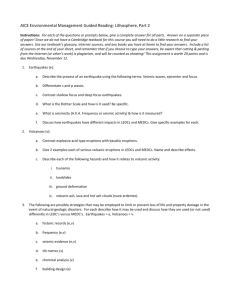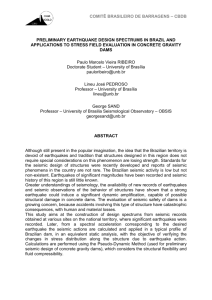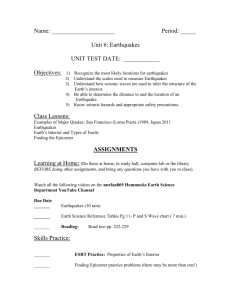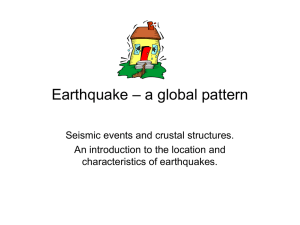seismic monitoring of strong earthquakes source areas
advertisement
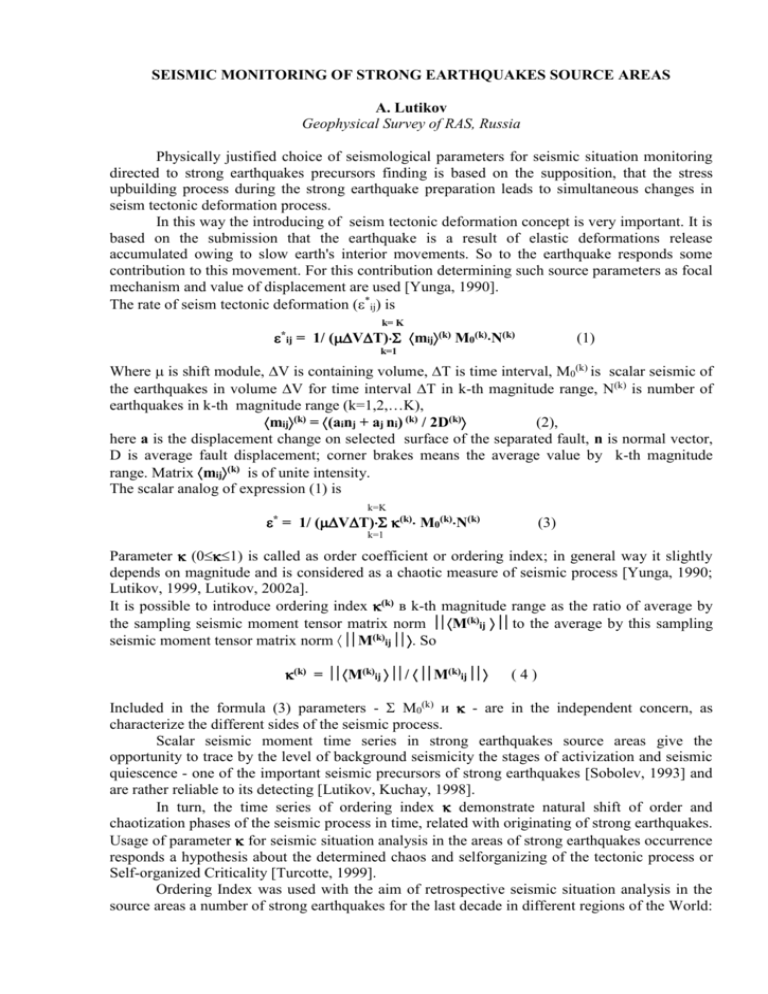
SEISMIC MONITORING OF STRONG EARTHQUAKES SOURCE AREAS A. Lutikov Geophysical Survey of RAS, Russia Physically justified choice of seismological parameters for seismic situation monitoring directed to strong earthquakes precursors finding is based on the supposition, that the stress upbuilding process during the strong earthquake preparation leads to simultaneous changes in seism tectonic deformation process. In this way the introducing of seism tectonic deformation concept is very important. It is based on the submission that the earthquake is a result of elastic deformations release accumulated owing to slow earth's interior movements. So to the earthquake responds some contribution to this movement. For this contribution determining such source parameters as focal mechanism and value of displacement are used [Yunga, 1990]. The rate of seism tectonic deformation (*ij) is k= K *ij = 1/ (VT) mij(k) M0(k)N(k) (1) k=1 Where is shift module, V is containing volume, T is time interval, M0(k) is scalar seismic of the earthquakes in volume V for time interval T in k-th magnitude range, N(k) is number of earthquakes in k-th magnitude range (k=1,2,…K), mij(k) = (ainj + aj ni) (k) / 2D(k) (2), here a is the displacement change on selected surface of the separated fault, n is normal vector, D is average fault displacement; corner brakes means the average value by k-th magnitude range. Matrix mij(k) is of unite intensity. The scalar analog of expression (1) is k=K * = 1/ (VT) (k) M0(k)N(k) (3) k=1 Parameter (01) is called as order coefficient or ordering index; in general way it slightly depends on magnitude and is considered as a chaotic measure of seismic process [Yunga, 1990; Lutikov, 1999, Lutikov, 2002a]. It is possible to introduce ordering index (k) в k-th magnitude range as the ratio of average by the sampling seismic moment tensor matrix norm M(k)ij to the average by this sampling seismic moment tensor matrix norm M(k)ij. So (k) = M(k)ij / M(k)ij (4) Included in the formula (3) parameters - M0(k) и - are in the independent concern, as characterize the different sides of the seismic process. Scalar seismic moment time series in strong earthquakes source areas give the opportunity to trace by the level of background seismicity the stages of activization and seismic quiescence - one of the important seismic precursors of strong earthquakes [Sobolev, 1993] and are rather reliable to its detecting [Lutikov, Kuchay, 1998]. In turn, the time series of ordering index demonstrate natural shift of order and chaotization phases of the seismic process in time, related with originating of strong earthquakes. Usage of parameter for seismic situation analysis in the areas of strong earthquakes occurrence responds a hypothesis about the determined chaos and selforganizing of the tectonic process or Self-organized Criticality [Turcotte, 1999]. Ordering Index was used with the aim of retrospective seismic situation analysis in the source areas a number of strong earthquakes for the last decade in different regions of the World: Shikotan (near South Kuriles), 04.10.1994, Mw=8.3; Kronotskoye (near East coast of Kamchatka), 05.12.1997, Mw=7.8; Taiwan, 20.09.1999, Mw=7.7; near the coast of New Britain, 04.06.2000, Mw=7.9; near West Coast of Peru, 23.06.2001, Mw=8.2. Besides it Tien Shan region was chosen as an example of continental area - here Susamir Earthquake in Kirghizia, 19.08.1992, Mw=7.3, was considered [Lutikov, 2002b]. 1.2 8 7.5 1 7 0.8 6.5 0.6 6 0.4 5.5 K 0.2 5 0 1977 1980 1983 1986 1989 T, years 1992 1995 1998 4.5 2001 Kav Kav-s Kav+s Mw max Mw m.e. Parameter's temporal dependence in Kronotskoye EQ, 05.12.1997, source area. For example, parameter's temporal dependence in Kronotskoye EQ source area is shown in the picture. Practically in all the cases considered the strong earthquake arises on a background of sharp ascending of parameter , to which one will precede its deep minimum. On the basis of comparing the results of analysis for all these earthquakes, it is possible to make conclusion that the phenomenon detected wears global nature. The paper is fulfilled at the support of fund RFBR, grants 02-05-64433, 04-05-64826 and fundamental program № 5 ONZ of RAS. Reference 1. Lutikov A.I. Elements of Tien Shan seismic mode in terms of seism tectonic deformation. // Materialy Vserossiyskoy shkoly-seminara «Geomorphology of Mountains and Forelands». Barnaul - Gorno-Altaisk, September, 24-30, 2002a, pp. 172-179. 2. Lutikov A., Kuchay M.S. Seismicity time variation in the areas of occurense a number of strong earthquakes in the North Caucasus. //1998. Journal of earthquake prediction research. V.7, No.1, pp.76-82. 3. Lutikov A. Seismicity monitoring of six strong earthquakes source areas (1976-2001) by one seismic moment tensor invariant in different regions of the world. // Europian Geo-physical Society. 27th General Assembly. Geophysical Research Abstracts. 2002b, V.4, CD. 4. Sobolev G.A., 1993, The foundations of earthquake prediction. // Moscow, Nauka, 313 pp. (rus) 5. Turcotte D.L. Seismicity and self-organized criticality. Physics of the Earth and Planetary Interiors, 111, 1999, pp. 275–293. 6. Yunga S.L. // 1990, Methods and results of studies of seismotectonic deformations. Moscow, Nauka, 191 pp. (rus)


